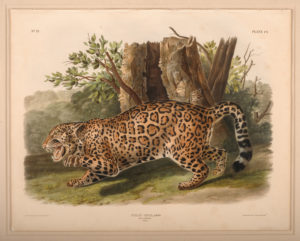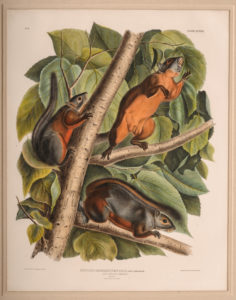Looking at the Collection: Audubon Quadrupeds
Haws Gallery
March 27 – June 19, 2022

John James Audubon (American, 1785 – 1851), Jaguar (Felis onca), hand colored lithograph. Printed by J.T. Bowen, Philadelphia, 1846. Collection of Mr. & Mrs. William H. Told, Jr.
John James Audubon
The Viviparous Quadrupeds of North America

John James Audubon (American, 1785 – 1851), Red-bellied Squirrel (Sciurus feruginiventris), hand colored lithograph. Printed by J.T. Bowen, Philadelphia, 1844. Collection of Mr. & Mrs. William H. Told, Jr.
In the 1830s, as renowned naturalist and artist John James Audubon (1785-1851) was completing the final plates for his monumental Birds of America series, he and his sons began to gather material for his second and equally ambitious undertaking. Planning to complete the definitive study of American wildlife, Audubon set out to document the animals of North America, and to present them in a format as impressive as he had used for his birds. The result of his years of field research, travel, and seemingly endless study was the Viviparous Quadrupeds of North America, the outstanding work on American animals produced in the 19th century.
The book was the product of Audubon’s collaboration with John Bachman, a minister, social activist and naturalist who wrote virtually all of the text accompanying Audubon’s illustrations. During the course of their partnership, tragedy struck the two men with the deaths of Bachman’s daughters Maria and Eliza, who were also the wives of Audubon’s sons John Woodhouse and Victor. The loss put a great strain on the relationship, but Audubon tried to heal the wound by dedicating himself with vigor to the project, promising Bachman “the very best figures of all our quadrupeds that have ever been thought of or expected.” Their project eventually yielded 150 folio drawings, hand printed and hand colored by J.T. Bowen of Philadelphia. The work was to be Audubon’s last. By 1846 the artist’s eyesight had failed to the point where he was no longer able to draw, leaving completion of the project to his two sons. With their father’s mental condition also deteriorating, they tried to keep him out of the public spotlight, partly to prevent bad publicity from hurting sales of the Quadrupeds. Audubon remained in a mostly incoherent state until his death on January 27, 1851.
This exhibition presents a selection of original Audubon prints from the Museum’s own collection of thirty-four viviparous quadrupeds, donated by Mr. & Mrs. William H. Told. The Tolds collected Audubon prints for nearly forty years, having received their first work — a marmot — as a gift. They appreciated the scientifically accurate animal subjects (some of which are now extinct), as well as the beautifully detailed backgrounds that often included native foliage and other naturalistic details.

